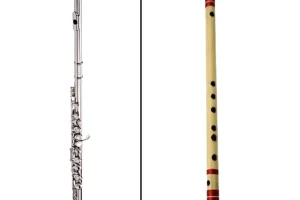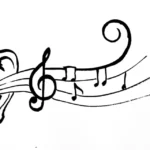It has been a topic of great intrigue amongst students of music around the globe, as well as discerning connoisseurs of music, to see and hear a simple musical instrument like flute, being performed in so many varied forms and with such diverse physical attributes in its construction.
There are several different versions of flute existing in almost every country, with their unique tuning systems. However, one of the two widely used forms are the quintessential western concert flute; and on the other extreme, the Indian bamboo flute lovingly called the Bansuri. In this online flute lesson, let us dive deep into their differences, as also their similarities.
A little about the western flute
The flute is a transverse (or side-blown) woodwind instrument that is closed at the blown end. It is played by blowing a stream of air over the embouchure hole. The pitch is changed by opening or closing keys that cover circular tone holes (there are typically 16 tone holes). Opening and closing the holes produces higher and lower pitches. Higher pitches can also be achieved through over-blowing, like most other woodwind instruments. The direction and intensity of the airstream also affect the pitch, timbre, and dynamics.
If you are learning to play the flute, either in person or through online flute lessons, you will be familiar with the standard concert flute, also called C flute, Boehm flute, silver flute, or simply flute, is pitched in C and has a range of about three and a half to four octaves starting from the note C4 (middle C). The flute’s highest pitch is usually given as either C7 or (sometimes) D7; however, more experienced flautists can reach up to F♯7. Some notes above this up to C8 are possible with extreme effort, but suffer greatly in tone, and are not typically considered part of the flute’s range. Modern flutes may have a longer foot joint, a B-footjoint, with an extra key to reach B3.
The piccolo is also commonly used in Western orchestras and bands. Alto flutes pitched a fourth below the standard flute, and bass flutes, an octave below, are also used occasionally.
The dimensions and key system of the modern western concert flute and its close relatives are almost completely the work of the great flautist, composer, acoustician, and silversmith Theobald Boehm, who patented his system in 1847. Minor additions to and variations on his key system are common, but the acoustical structure of the tube remains almost exactly as he designed it. Read more Why you should learn ‘The Bansuri’.
Salient features of Bansuri
The Bansuri has been an ancient instrument, with the current form being so since time immemorial. Traditionally, it is made of bamboo, cultured and selected carefully by expert flute-makers. One of the two hollow ends is closed using a wooden cork to enable unilateral passage of air. Other than the blowing hole, six holes change the effective length of the flute by opening and closing them in different combinations. This brings about the different pitches, from lower to higher. There are no keys and the player can either open, close or have the holes open in varying degrees as per the tonal requirements. This feature helps in gradually sliding between different notes. It also allows for the production of microtonal pitches.
The tuning that is followed is that of Pythagorean or Just-intonation. Thus, each flute is tuned to a particular diatonic key, as ordered by the flute player.
There are Bass Flutes, which are the mainstay at Indian classical concerts. The common key for a typical Indian classical concert is either E, D or A as the tonic note. The Tanpura needs to be then tuned as per the tuning of the flute key in use for the concert, to provide harmonic support. Many of the best online flute lessons involve progression that will familiarize you with most types of flutes.
Apart from the Bass Bansuri, there is higher-pitched Bansuri, which sounds an octave higher. The high-pitched Bansuri is of great use in performing semi-classical compositions towards the end of a concert.
To know more and get started with the bansuri journey, visit: www.themysticbamboo.com; it is one of the best online flute lessons where you can self-learn from the comfort of your home at your own pace.
Contrasting features with Indian flute
One of the most significant differences between the Indian and Western systems of music, apart from the flutes, remains the use of sliding notes or Gamak and Meend, as it is called in Indian literature.
Western music as such does not employ the use of extensive sliding between two notes, in their compositions. You would have realized it if you are taking online flute lessons and have started practising on your own. The reason for this is that the instrument makers and designers never felt the need to design an instrument that was capable of that technique. The western flute instead has keys that allow the performers to play chromatic notes with ease, as each note has a clearly defined method of sound production.
Indian flutes, on the other hand, are designed to enable the musician to glide and slide between two notes quite far apart on the scale.
Secondly, the Bansuri is limited in its range, having a range of only two and a half octaves. The ability to sound chromatic notes is also considerably difficult as compared to its western counterpart.
The difficulty in playing chromatic notes is a virtue that allows the Bansuri player to venture into microtonality.
The western flute, in this aspect, is very restrictive as far as microtonal freedom is concerned.
Another major difference between them is that of the tuning. This is a byproduct of the differences in the tunings of the two schools of music more than the instruments themselves.
Western music follows an equal temperament style of tuning allowing the player to collaborate with other instruments, as well as the ability to transpose between different keys without sounding out of tune.
Indian music system rather follows the ‘just intonation’ method of tuning. As a result, transposing to different keys comes at the cost of sounding out of tune; thereby making it imperative to have a different instrument for each key. Thus, an exponent of classical Indian Bansuri tends to have a collection of several flutes in different keys.
The western flutes are a ‘family’ based on their tonal range and quality of timbre.
From high to low, the members of the concert flute family include the following:
Each of the instruments has its range.
The piccolo reads music in C (like the standard flute), but sounds one octave higher.
The alto flute is in the key of G, and the low register extends to the G below middle C; its highest note is a high G.
The bass flute is an octave lower than the concert flute, and the contrabass flute is an octave lower than the bass flute.
Less commonly seen flutes include the treble flute in G, pitched one octave higher than the alto flute; soprano flute, between the treble and concert; and tenor flute or flûte d’amour in B♭, A or A♭ pitched between the concert and alto.
The lowest sizes (larger than the bass flute) have all been developed in the 20th century; these include the sub-bass flute, which is pitched in F, between the bass and contrabass; subcontrabass flute (pitched in G or C), contra-alto flute (pitched in G, one octave below the alto), and double contrabass flute in C, one octave lower than the contrabass. The flute sizes other than the concert flute and piccolo are sometimes called harmony flutes. These are used often in an orchestra simultaneously to provide harmonic counter-melodies. If you are looking for the best online flute lessons, make sure you research what kind of flutes the course introduces you to.
The Bansuri, on the other hand, is usually the only lead instrument in a concert and the only harmonic support is from a drone or Tanpura.
Apart from the above-mentioned differences, one of the minor differences remains to be the material from which the two flutes are constructed.
The Indian flute traditionally is made of bamboo. Other materials are being used in recent times that include different kinds of wood, synthetic carbon fibre materials, etc. The bamboo continues to enjoy a place of affection for Bansuri players as the most favoured material. It is because of the warm tonality that is only possible with a bamboo flute.
Western flute: Construction materials
Less expensive flutes are usually constructed of brass, polished and then silver-plated and lacquered to prevent corrosion, or silver-plated nickel silver (nickel-bronze bell metal, 63% Cu, 29% Zn, 5.5% Ni, 1.25% Ag, .75% Pb, alloyed As, Sb, Fe, Sn). More expensive flutes are usually made of more precious metals, most commonly solid sterling silver (92.5% silver), and other alloys including French silver (95% silver, 5% copper), “coin silver” (90% silver), or Britannia silver (95.8% silver)
To sum it up with a table:
| Western Flute | Bansuri |
| Made of alloys including silver and brass | Made from natural bamboo |
| Has 16 holes | Has 6 holes plus the blowing hole |
| Needs assembly of different parts-mouthpiece, keys and foot joint | Is a single unit; does not need assembly |
| Has a range of three and a half to four octaves | Has a range of two and a half octaves |
| Has keys with an internal tubing system | Has holes in the bamboo at calculated lengths |
| Every note is defined clearly on the keys | Chromatic notes are arbitrary and need ear-training for accurate tone production |
| Slide notes are restricted to adjacent notes and need extended techniques. | Slide notes are an essential feature of classical repertoire and are very frequently used. Sliding between distant notes is also commonly used. |
| Equal temperament tuning is used. | Just-intonation tuning is used. |
| Simultaneous counter-melodies on harmony flutes are common | Usually only a single lead player with a drone as the harmonic support. |
| Timbre is more of a metallic character | Has a more warm, natural, woody timbre |
The idea that different materials can significantly affect the sound quality is under some contention, and some argue that different metals make less difference in sound quality than different flautists playing the same flute.
Even Verne Q. Powell, a flute-maker, admitted (in Needed: A Gold Flute or a Gold Lip?) that “As far as tone is concerned, I contend that 90 percent of it is the man behind the flute”.




